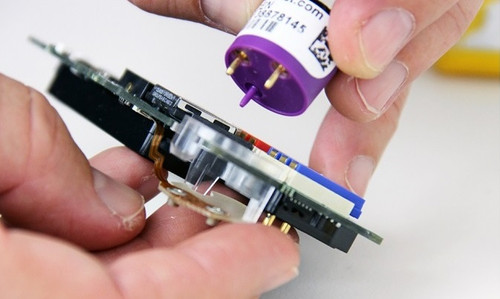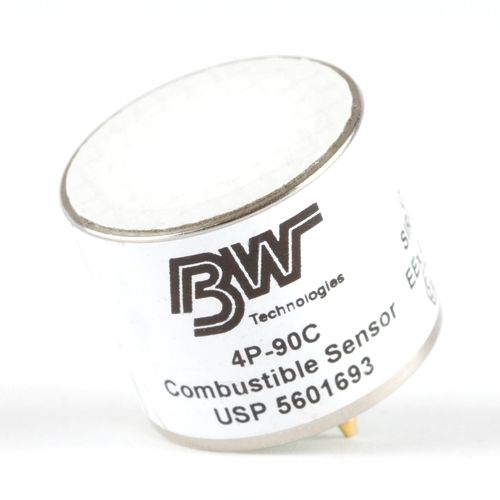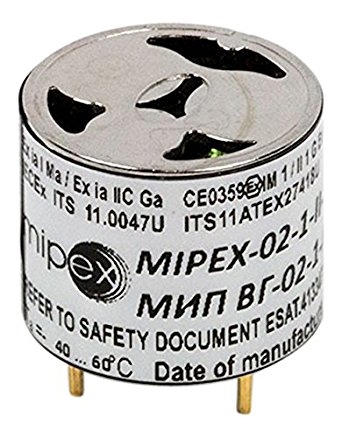Catalytic Gas Detector: How Catalytic Bead Sensors Work and Why O2 Sensors Are Important
Confined spaces found in refineries, chemical plants, and mines, may contain toxic and combustible gases and lack a safe level of oxygen. Inspecting and working in these types of spaces requires reliable gas detection in order to stay safe and be aware of any danger before entering, and knowing when to ventilate or evacuate. A lot of our customers look for the highest level of protection combined with the lowest cost of ownership. The solution can come down to choosing a catalytic bead or a non-dispersive infrared (NDIR) sensor technology. Which technology will work best for your application? Both approaches have their advantages and disadvantages.
What Is Catalytic Combustion And How Does It Work?
The accurate and reliable catalytic bead sensor has been used for combustible gas detection for about 50 years. This kind of gas sensor is engineered on the basis of the catalytic combustion (oxidation). Here is how it works: combustible gas mixtures start burning when they reach their ignition temperature. In the presence of some chemicals, a gas molecule oxidizes at a lower than regular ignition temperature, which speeds up the process. Some metal oxides and their compounds have excellent catalytic properties . Coating gas sensors with suitable metal oxides helps improve their stability. The benefits of the catalytic sensors are that they are inexpensive, reliable, and non-gas-specific.
What Can Percent LEL Combustible Gas Sensors Measure?
Lower Explosive Limit (LEL) indicates the minimum concentration of gas in the air that will ignite and explosively burn if there is a source of ignition. The atmosphere will start burning under the following conditions: it must contain an adequate level of oxygen and fuel, a source of ignition, and the molecular energy sufficient enough to sustain the fire chain reaction. These four conditions form the Fire Tetrahedron.
A catalytic bead combustible sensor can measure the concentration of combustible gases up to 100% of the LEL. The readings will be most accurate when a monitor is used to detect the same gas that it was calibrated with. When a gas other than the calibration gas is detected, the reading will be relative to the calibration gas. In this case, a Correction Factor (CF) is used to determine the actual concentration of this gas.
The BW GasAlert Micro 5 Series Replacement Lower Explosive Limit (LEL) Sensor
Note that some airborne substances have a detrimental effect on catalytic sensors causing their loss of sensitivity (poisoning). The list of these substances includes polishes, waxes, lubricants, heat transfer fluids, caulking materials, and personal care products containing cyclic methylsiloxanes, polydimethylsiloxanes, or cyclomethicone. To prevent sensor poisoning, manufacturers add internal filters that block harmful molecules from entering the sensor. The larger the molecule, the slower it diffuses into the bead, and the longer it takes to get oxidized. If your application requires detection of more complex hydrocarbons, or alcohols, an unfiltered catalytic bead combustible sensor is recommended.
Because catalytic sensors lose sensitivity so easily, they have to be tested on a regular basis. Bump testing is the only way to determine if the catalytic sensor is still able to detect combustible gases.
Why Are O2 Sensors Important?
It is important to know that you cannot rely on the catalytic bead combustible sensor readings if the oxygen concentration in your environment is less than 10% v/v. There has to be enough oxygen to support catalytic oxidation. In addition, there needs to be a healthy range of oxygen for someone to be in the environment without bringing their own oxygen in. This is why portable safety gas monitors with a catalytic bead sensor must include an oxygen sensor to measure the concentration of oxygen in the environment.
The electronic device used to measure the amount of oxygen in a liquid or a gas was invented in the late 1960s by Dr. Gunter Bauman. Here is what an oxygen sensor for a portable gas detector looks like now:
RAE Systems Replacement Oxygen Sensor
NDIR vs. Catalytic Bead Technology
Non-dispersive infrared (NDIR) combustible gas sensing technology is based on a gas molecules’ absorption of infrared energy by the bonds of dissimilar atoms. Non-dispersive IR sensors measure gases at a specific range of wavelengths associated with a particular gas.
Gas Clip Technologies LEL Replacement Infrared Sensor
It is a less commonly used technology, mostly because it has some limitations. NDIR sensors cannot be used to measure gases that do not absorb infrared light: diatomic molecules like oxygen, nitrogen, and hydrogen. The disadvantages also include warm-up time and cost. A portable gas detector with the NDIR combustible gas sensor requires up to 5 minutes warm-up time after it has been turned on before the sensor readings become accurate. In addition, NDIR sensors are 3-4 times more expensive than catalytic bead sensors. The advantage of using NDIR sensors is that they are not affected by contaminants, do not require oxygen, and use less power.
Knowledge of capabilities and limitations of different sensing technologies is important when determining what portable gas detector to select for your application. NDIR combustible sensors provide a good solution in certain applications: it responds well to large hydrocarbon molecules that cannot be measured by a standard LEL sensor and can be used for high-range measurement. In harsh environments, like refineries, IR detectors provide reliable fail-to-safe operation. However, they must be checked regularly to verify that a gas can enter the optical path, as dust shields can become blocked.
For everyday use, when combustible gas hazards vary, the catalytic bead combustible sensor is the most commonly used technology in portable gas monitors. In severe climates with temperature extremes, high humidity, or around vibrating machinery, catalytic detectors are the best choice to ensure occupational safety.
Both catalytic and IR-based sensors are reliable, fast detecting and accurate if you use them correctly.
To summarize, here is a table of sensor capabilities:| Sensor Type | Detects LEL range C1-C5 hydro-carbon gases (methane, ethane, propane, butane, pentane, natural gas) | Detects LEL range C6-C9 hydro-carbon gases (hexane, heptanes, octane, nonane) | Detects LEL range heavy fuel vapors (diesel, jet fuel, kerosene, etc.) | Detects heavy fuel vapors in low ppm range (diesel, jet fuel, kerosene, etc.) | Used in low oxygen atmospheres | Vulnerable to sensor poisoning | Used for high range combustible gas measurement (100% LEL & higher) | Detects H2 |
|---|---|---|---|---|---|---|---|---|
| Catalytic LEL Sensor | Yes | Yes | No | No | No | Yes | No | Yes |
| NDIR Sensor | Yes | Yes | Yes | Yes | Yes | No | Yes | No |
Give us a call at 800-829-9580 and speak with our gas detection experts to find out the best solution for your application, or visit us online at pksafety.com for more information.
References:
- Common Combustible Gas Sensing Technologies in Portable Detectors, William Ball & Andrew Saunders, HA University, 017 February 09 Rev. 3
- Calibrating and Testing Direct-Reading Portable Gas Monitors
- Industrial Safety and Hygiene News
Related Searches
PM400, Gas Monitors, LEL Monitor, P2G
Recent Posts
-
Promoting Safety: National Work Zone Awareness Week is April 15-19, 2024
Each year, the National Work Zone Awareness Week (NWZAW) places the spotlight on the importance o …Apr 11th 2024 -
Understanding 4 Gas Monitors: How They Work & Why They Are Important
In today’s increasingly dynamic industrial landscape, 4 gas monitors have emerged as critical com …Apr 8th 2024 -
April Showers Require Workers to Wear Hi-Vis Safety Rain Gear
While April showers bring May flowers, they also bring challenges, particularly for those working …Apr 1st 2024








